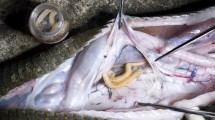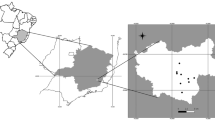Abstract
Many primate populations are severely threatened by human activity. Illegal hunting with snares frequently causes fatal injuries and permanent mutilations in wild primates. Traumatic injuries and stressful experiences can reduce the efficacy of the immune system to fight parasitic infections. Snare-related changes in primate behavior may also influence the probability of exposure to parasites. We hypothesized that primates with permanent snare-related injuries would have a higher prevalence of intestinal parasites than control individuals. We tested the relationship between snare injuries and the prevalence of intestinal parasites in wild chimpanzees (Pan troglodytes) of Budongo forest, Uganda. We collected 487 fecal samples from known individuals (70 control and 20 snare-injured chimpanzees) and used flotation and sedimentation to isolate helminth eggs and an immunochromatographic assay to identify protozoan cysts. We found that the prevalence of Strongylida nematodes was significantly higher in snare-injured chimpanzees than in control individuals. In contrast, we found no association between snare injuries and three other parasite taxa: Ascaris, cestode, and Cryptosporidium parvum. Our study suggests that snare-injured primates may have higher exposure and/or be more susceptible to developing infections with helminth parasites than control individuals. Future studies should investigate whether snare injuries influence parasite prevalence in other species of wild primates.

Similar content being viewed by others
References
Barrows, M. (1996). A survey of the intestinal parasites of the primates in Budongo Forest. Project for Glasgow University. Uganda: Glasgow University.
Byrne, R. W., & Stokes, E. J. (2002). Effects of manual disability on feeding skills in gorillas and chimpanzees. International Journal of Primatology, 23, 539–554.
Coe, C. L. (2012). Immunity in primates within a psychobiological perspective. In G. Demas & R. J. Nelson (Eds.), Ecoimmunology (pp. 144–164). Oxford: Oxford University Press.
Davis, P. J. (2008). The immunology of wound healing: the body as a battlefield. Wounds UK, 4, 54–69.
Fa, J. E., Ryan, S. F., & Bell, D. J. (2005). Hunting vulnerability, ecological characteristics and harvest rates of bushmeat species in Afrotropical forests. Biological Conservation, 121, 167–176.
Ghai, R.R., Fugère, V., Chapman, C.A., Goldberg, T.L., & Davies, T. J. (2015). Sickness behaviour associated with non-lethal infections in wild primates. Proceedings of the Royal Society of London B: Biological Sciences, 282. doi:10.1098/rspb.2015.1436.
Gillespie, T. R. (2006). Noninvasive assessment of gastrointestinal parasite infections in free-ranging primates. International Journal of Primatology, 27, 1129–1143.
Hermans, V. (2011). Ranging behaviour of snare-injured female chimpanzees (Pan troglodytes schweinfurthii) of the Sonso community in the Budongo Forest, Uganda. MRes Primatology, University of Roehampton.
Hobaiter, C., & Byrne, R. W. (2010). Able-bodied wild chimpanzees imitate a motor procedure used by a disabled individual to overcome handicap. PLoS ONE, 5, e11959.
Janeway, J.A., Travers, P., Walport, M., & Shlomchik, M. (2001). The front line of host defense. In immunobiology: The immune system in health and disease (pp. 52–59). New York: New Garland Science.
Krief, S., Hladik, C. M., & Haxaire, C. (2005). Ethnomedicinal and bioactive properties of plants ingested by wild chimpanzees in Uganda. Journal of Ethnopharmacology, 101, 1–15.
Matsubayashi, H., Yokogawa, M., Morishida, T., Ohosuru, M., Asami, K., et al. (1965). Handbook of parasitology. Tokyo: Asakura.
Mugisha, L. (2004). A survey of gastrointestinal parasites of habituated wild chimpanzees (Pan troglodytes), humans and rodents in Budongo Forest Reserve. M.Sc. thesis, Makerere University.
Munn, J. (2006). Effects of injury on the locomotion of free-living chimpanzees in the Budongo Forest Reserve, Uganda. In N.E. Newton-Fisher, H. Notman, J.D. Paterson, & V. Reynolds (Eds.), Primates of western Uganda (pp. 259–280). Developments in Primatology: Progress and Prospects. New York: Springer Science + Business Media.
Mwavu, E. N., & Witkowski, E. T. F. (2008). Land-use and cover changes (1988–2002) around Budongo Forest Reserve, NW Uganda: implications for forest and woodland sustainability. Land Degradation & Development, 19, 606–622.
National Environment Management Authority. (2010). State of the environment report for Uganda 2010. Kampala: National Environment Management Authority.
Noss, A. J. (1998). The impacts of cable snare hunting on wildlife populations in the forest of the Central African Republic. Conservation Biology, 12, 390–398.
Plumptre, A. J., & Reynolds, V. (1997). Nesting behavior of chimpanzees: implications for censuses. International Journal of Primatology, 18, 475–485.
R Core Team (2014). R: a language and environment for statistical computing. Vienna, Austria: R Foundation for Statistical Computing. Available at: http://www.R-project.org/.
Reynolds, V. (2005). The chimpanzees of the Budongo forest: Ecology, behaviour, and conservation. Oxford: Oxford University Press.
Sadd, B. M., & Schmid-Hempel, P. (2009). Principles of ecological immunology. Evolutionary Applications, 2, 113–121.
Skrjabin, K.I., Shikhobalova, R.S., Schulz, T.I., Boev, S.N., & Dellyamure, S.L. (1952). Strongylata. In Key to parasitic nematodes III (pp. 883). Moscow: Akad.
Smith, R. (1995). Some effects of limb injuries on the chimpanzees of the Budongo Forest Budongo Forest Project Reports.
Stokes, E. J., & Byrne, R. W. (2001). Cognitive capacities for behavioural flexibility in wild chimpanzees (Pan troglodytes): The effect of snare injury on complex manual food processing. Animal Cognition, 4, 11–28.
Strait, K., Else, J. G., & Eberhard, M. L. (2012). Parasitic disease of nonhuman primates. In C. R. Abee, K. Mansfield, S. D. Tardif, & T. Morris (Eds.), Nonhuman primates in biomedical research: Diseases (2nd ed., pp. 197–297). San Diego: Academic.
Taylor, M.A., Coop, R.L., & Wall, R. (2007). Parasite taxonomy and morphology. In Veterinary parasitology (pp. 8–12). Oxford: Blackwell.
Tumusiime, D. M., Eilu, G., Tweheyo, M., & Babweteera, F. (2010). Wildlife snaring in Budongo Forest Reserve, Uganda. Human Dimensions of Wildlife, 15, 129–144.
Waller, J. (1995). The aetiologies of major limb injuries amongst chimpanzees in the Sonso area of the Budongo Forest, Uganda. M.Sc. thesis. University of Oxford.
Zommers, Z. (2010). Impact of human disturbance in Budongo Forest, Uganda, on four communities of chimpanzees. PhD thesis, Oxford University.
Zommers, Z., Macdonald, D. W., Johnson, P. J., & Gillespie, T. R. (2013). Impact of human activities on chimpanzee ground use and parasitism (Pan troglodytes). Conservation Letters, 6, 264–273.
Acknowledgments
We are grateful for the support of the field assistants, staff, and researchers of the Budongo Conservation Field Station (BCFS). We thank the Uganda Wildlife Authority and the Uganda National Council for Science and Technology for permission to conduct this project. We thank the Royal Zoological Society of Scotland for providing core funding to the BCFS. We thank the ARCUS Foundation for funding the Chimpanzee Monitoring Programme. Funding for fieldwork was provided by the Institute of Biology and the Fonds des Donations of the University of Neuchâtel, as well as the M. Wüthrich and A. Mathey-Dupraz Foundation and an ERC grant (PRILANG 283871) to K. Zuberbühler. We thank the reviewers and the editor for their helpful comments.
Author information
Authors and Affiliations
Corresponding author
Ethics declarations
Conflict of Interest
The authors have no conflict of interest or any competing financial interest.
Ethical note
This research complied with ethical requierements for research involving animals as established by “Uganda Wildlife Authority” and “the Ugandan National Council for Science and Technology”.
Additional information
Handling Editor: Joanna M. Setchell
Rights and permissions
About this article
Cite this article
Yersin, H., Asiimwe, C., Voordouw, M.J. et al. Impact of Snare Injuries on Parasite Prevalence in Wild Chimpanzees (Pan troglodytes). Int J Primatol 38, 21–30 (2017). https://doi.org/10.1007/s10764-016-9941-x
Received:
Accepted:
Published:
Issue Date:
DOI: https://doi.org/10.1007/s10764-016-9941-x




